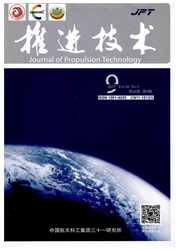

 中文摘要:
中文摘要:
为了研究时序效应对尾迹传递过程的影响,利用基于密度修正的求解雷诺平均N-S方程的商用CFD软件对某一1.5级轴流低压涡轮级进行了详细数值模拟。通过调整第二级导叶的周向位置来产生时序效应,结合涡轮级中湍动能分布、叶片表面剪切应力分布等来详细分析时序效应对涡轮流场的影响。结果表明:同名叶栅数量比例是影响时序效应的一个重要因素,文中时序效应对涡轮效率影响很小,涡轮最大和最小气动效率之间相差0.1%。时序效应对涡轮性能的影响主要体现在尾迹与主流之间的掺混损失和尾迹诱导的边界层转涙损失两方面。当一条进口导叶尾迹在靠近出口导叶吸力面流过通道而与其相邻的另一条尾迹通过出口导叶压力面附近时,涡轮效率最大;当一条进口导叶尾迹撞击在出口导叶前缘而另一条尾迹从出口导叶通道中部通过时涡轮效率最小。
 英文摘要:
英文摘要:
To give insight into the clocking effect on the wake transportation process,the unsteady three-dimensional flow through a 1.5-stage axial low pressure turbine is simulated numerically using a density-correction based,Reynolds-averaged Navier-Stokes equations commercial CFD code.The 2nd stator clocking is applied over ten equal tangential positions.The turbine flow field is analyzed in details according to the distribution of turbulent kinetic energy and wall strain stress in the outlet stator.The results show that the harmonic blade number ratio is an important factor affecting the clocking effect.The clocking effect has a very small influence on the turbine efficiency in this investigation.The efficiency difference between the maximum and minimum configuration is nearly 0.1%.The influence of clocking effect on turbine performance is mainly embodied in the mixing loss between wake and mainstream and the wake-induced transitional loss.The maximum efficiency can be achieved when the 1st stator wake enters the 2nd stator passage near blade suction surface and its adjacent wake passes through the 2nd stator passage close to blade pressure surface.The minimum efficiency appears if the 1st stator wake impinges upon the leading edge of the 2nd stator and its adjacent wake of the 1st stator passed through the mid-channel in the 2nd stator.
 同期刊论文项目
同期刊论文项目
 同项目期刊论文
同项目期刊论文
 期刊信息
期刊信息
